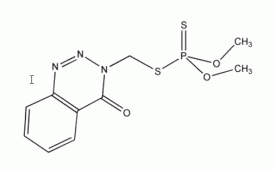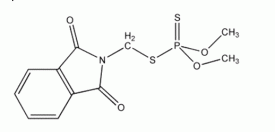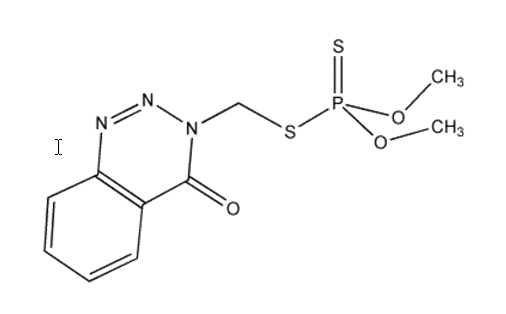Editor’s note: This post was written by John Abbotts, a former Sightline research consultant and a long-time friend of Sightline.
It’s been almost 50 years since Rachel Carson published Silent Spring, sparking public concern about the dangerous side-effects of chemical pesticides. In the book, she flagged organophosphate pesticides, which are neurotoxins derived from nerve agents developed during WWII. Yet despite their well-known dangers, organophosphate insecticides are still used in the US, including in Northwest apple orchards, a half century later.
Two organophosphates used on apples are Azinphos-methyl (AZM) and Phosmet. Both children and adults face dietary exposures through consumption of pesticide residues on produce and processed foods, such as dried or canned fruits. Pesticides also pose health risks to the workers who apply them, as well as to members of farm worker families from “take-home” exposure pathways; residual pesticides that cling to workers’ clothing or drift from field spraying that ends up in homes and soil, where children may be exposed. Research at the University of Washington and elsewhere has documented the exposure of farm worker family members to AZM and Phosmet through these “take home” pathways.

There are safer and cost-effective solutions at hand, but it’s taken decades of foot-dragging, delay, and lawsuits to bring about significant reductions in organophosphate use. To understand why the Northwest is still living with AZM and Phosmet—and why next year is so important—a little history is in order.
AZM was first registered for use in the US in 1959, and Phosmet in 1966. Since the 1960s, AZM has been the pesticide most used by Washington apple growers to control coddling moth, the leading pest in Western apple orchards, and the source of the proverbial “worm in the apple,” which later develops into the adult moth. As recently as 2008, fully 80 percent of Washington’s apple growers reported use of AZM. Of the AZM used on US apples in 2007, approximately 65 percent was used in Washington, where about half of the country’s apples are grown.
Carrying on Carson’s legacy, Congress amended legislation on pesticide regulation in 1988 and again in 1996, collectively requiring the scientific reexamination of pesticides approved decades before, and tightening standards for evaluating pesticide risks. In 1996, for example, legislators required an extra 10-fold safety factor in determining acceptable exposures to children, compared to those for adults (unless the scientific database supports a lower safety factor for children). Children consume more fruits and other foods per unit of body weight than adults, and biological systems are still developing in children, putting them at greater risk to pesticides and other chemicals that can harm development.
In October 2001, exactly a decade ago, the EPA issued its official risk assessments of AZM and Phosmet. The Agency concluded that 35 uses of AZM should be cancelled immediately or phased out over four years. The remaining 10 uses, including for apples and other tree fruits, were granted “time-limited” uses for an additional four years, after which time the EPA would evaluate applications from chemical companies for renewal of those uses, but only if supported by additional data. EPA’s risk assessment also concluded that even for some of the remaining uses, the time lag between when AZM is applied to a crop and when workers could reenter the field with an adequate safety margin, was actually longer than the harvest season, which would have rendered use of the pesticide impractical.
For Phosmet, EPA determined that 3 uses should be cancelled immediately, 33 uses were eligible for “reregistration,” and 9 uses, again including apples and other fruits, would be granted “time limited” registrations.
In January 2004, the United Farm Workers, AFL-CIO, Hispanic community groups, and other groups sued the EPA on the grounds that the Agency had inadequately considered the risks of AZM and Phosmet. By December of the following year, the EPA had reached a negotiated settlement with the plaintiffs, promising that by April 2006, EPA would propose a decision on the “time-limited” uses of AZM and Phosmet. Then in November of that year, EPA declared, based on its reevaluation, that AZM use on apples and other crops would be phased out and completely cancelled by September 30, 2012.

In January 2007, EPA decided to retain the 9 uses of Phosmet, but lengthened most of the “Restricted Entry Intervals”—the times when workers had to stay out of the fields after applying the pesticide—and imposed some additional mitigation measures to protect both workers and bystanders.
The next month, the Plaintiffs reopened their lawsuit, arguing that AZM use extending into 2012 was far too long for continued exposures to workers and their families, and advocating more mitigation measures for Phosmet uses. That suit was argued in federal district court in February 2008, but no decision has yet been issued. Even if a final legal determination is not issued before September 2012, the standing cancellation deadline for AZM, the plaintiffs still advocate stricter limits on Phosmet.
In the meantime, in April 2006, Health Canada also decided that AZM uses would be phased out in that country. In July 2007, Health Canada announced that the last date of use for AZM would be December 31, 2012.
Will banning the pesticides harm the apple industry? It seems unlikely.
In October 2010, the Washington State University Extension issued an analysis of the expected impacts to apple growers, and Washington generally, from the ban on AZM. The researchers concluded that no single chemical could provide a one-to-one replacement for AZM, but that a combination of non-organophosphate chemicals could replace AZM with minimal adverse economic effects. The mix of pesticides in scenarios both with and without AZM included pheromones, which are natural biochemicals. Spraying pheromones in an apple field, for example, overwhelms the ability of coddling moths to detect potential mates, forcing them to move elsewhere to look for mates. Pheromones alone, however, were not deemed sufficient to replace AZM.
The WSU analysis concluded that the combination of replacement pesticides—all of which had lower impacts on human health and the environment than AZM or Phosmet— would modestly reduce apple sales (by 0.8 percent), modestly increase prices (by 0.2 percent), and also increase employment (by 0.1 percent) in the Washington apple industry, with negligible impacts on the overall state economy.
An even smarter approach to the replacement pesticides might be organic farming, as research demonstrates. Investigators from three different Washington State University Agricultural Departments compared three options for establishing an apple orchard: conventional farming with pesticides; organic farming; and integrated farming, using a combination of organic and conventional methods. The study evaluated these production systems in Washington from 1994 to 1999, and concluded that all three systems produced similar apple yields, but the organic system ranked first in both environmental and economic sustainability, the integrated system second, and the conventional system last. The initial costs to establish the organic system were higher than for the conventional system, but consumer willingness to pay higher prices for organic apples led that system to reach a profitable break-even point even more quickly than the other options. The WSU results were published in the scientific journal Nature in April 2001.
By next year at this time, use of harmful organophosphates in the region should be significantly curtailed. Given the popularity of organic produce, the documented replacement strategies for conventional pesticides, and the well-understood dangers of AZM and Phosmet, there should be no reason to delay the ban and restrictions yet again. Replacing organophosphates with more sustainable alternatives would be a fitting commemoration for the signal warning that Rachael Carson gave us 50 years ago.


Comments are closed.